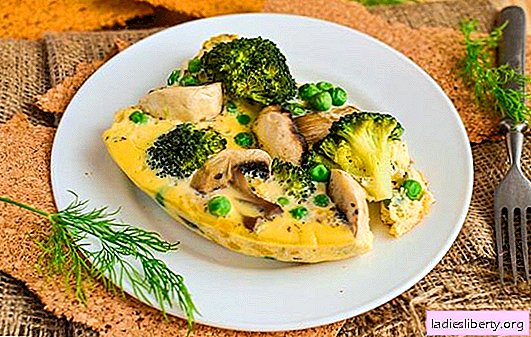
A bunch of nuts or dried fruits in boiled fruit juice - such is churchkhela. One of the oldest and most nutritious goodies can not only be bought, but also easily prepared at home. The taste qualities of churchkhela are infinitely diverse, as are its beneficial properties.
About how the subtleties of manufacture affect the benefits of churchkhela and the history of goodies
Before sugar became a generally available product, sweets were usually prepared at best with an admixture of honey, or even without it at all. Even in Ancient Mesopotamia churchkhela was known - a garland of nuts covered with boiled grape juice.
Thus, the surplus of the crop was consumed and stocked up with an incredibly nutritious product, suitable for long-term storage without special conditions. Churchkhela was brought along by warriors, travelers and merchants of the Great Silk Road.
Churchkhela manufacturing technology, especially at home, has not changed much since then, and today nutritionists rightly rank it among the most harmless and healthy treats.
There are many varieties of this oriental sweetness - Georgian, Abkhazian, Gurian, Mingrelian, Imeretian and many others - the essence of churchkhela is simple, but diverse.
· For its basis (mixed or from one ingredient) take nuts - walnuts, hazelnuts, cashews, pistachios, peanuts, pecans and others. Dried fruits - prunes, figs, dried apricots, raisins, as well as candied fruits and dried berries. Nuts are cleaned from shells and thin peels, and often dried. Any base is strung on a strong thread.
· Juice can be not only grape (the sweetness turns light chocolate), but also pomegranate (bright red), apple (amber), or plum, cherry, apricot. If in former times they were content with it in its pure form, today it is often sweetened with sugar or honey. The main thing is to boil it over low heat, to evaporate part of the liquid from it until it becomes thick, almost like liquid honey. For thickening the juice, corn or wheat flour can be taken.
· Then, dip the thread with the base of the sweets into the prepared toffee, usually more than once - 2-6 repetitions, between which the churchkhela is slightly dried. As a result, nuts or anything else should be covered with a fruit or berry layer of no less than their volume.
· Now churchkhela is sent for drying for a week or two in a dark, dry and non-hot room. Sometimes this is combined with drying it in the sun. As a result, the sweetness should harden, but not to the marble hardness, but in such a way that it can be handled with comfort and pleasure and teeth, without damaging them.
· Then for the ripening of churchkhela it takes another 1-2 months, during which it is kept in boxes, shifted with parchment or waxed paper.
Sometimes churchkhela is crushed in crushed nuts, sesame seeds, coconut flakes, and coated with chocolate to improve the taste.
But a completely natural product is a curiosity in our time. Therefore, artificial church colors may contain artificial colors, flavors, flavor enhancers, thickeners, preservatives, sweeteners. Naturally, this does not add churchkhel benefits, but it can easily make it harmful to the body.
Therefore, in order to enjoy churchkhela with pleasure and without a shadow of harm, you need to approach her choice with great attention or cook at home, which is not at all difficult.
The benefits of churchkhela in general
The nutritional and beneficial properties of churchkhela are based primarily on the raw materials used for its manufacture. What is the same grape or plum, pistachio or raisin useful - the more useful it is.
But, if we take and compare any varieties of churchkhela, we can also name what unites them in the sense of benefit and harm.
All a few pieces of it, eaten without haste and washed down with green tea or good coffee, will instantly feel better, feel a surge of vivacity and good mood. It will be useful in the case when you need to think a lot - at work or study.
Easily digestible sugars from fruits and berries are involved in all of this.
The average nutritional value of 100 g of churchkhela is about 500 kcal.
This delicacy is nutritious, nutritious, easy to digest and does not overload the digestive system, for a long time, as already mentioned, it allows you to feel pleasant satiety.
Due to its high caloric value, churchkhela can be recommended for quick weight gain.
Juices of fruits rich in pectins (grapes, apple, apricots) help lower blood cholesterol and remove harmful substances from the body.
Organic acids from this delicacy are absorbed no worse than sugars, and are actively involved in metabolic processes. They normalize the water-salt balance and support for chronic fatigue.
Walnut churchkhela, rich in essential amino acids and vegetable fats, strengthens the immune system, relieves symptoms of anxiety and sleep disturbances.
It is important to note that the mineral and other beneficial substances present in fresh fruit juices, as a result of the technology for making churchkhela, turn out to be 2-3 times higher in this treat in comparison with the initial raw materials.
How is the use of churchkhela for specific diseases and disorders
Churchkhela's nutritional composition makes it an ideal choice for important occasions:
· Increased carbohydrate content - will restore strength in case of insufficient, unbalanced nutrition;
· Sugar from fruits and amino acids of nuts, which help their absorption, make it a very useful snack for hypoglycemia;
Churchkhela with a mixed, rich composition, for example - hazelnuts, walnuts, dried apricots, raisins, cherry juice - can be a means of preventing vitamin deficiency.
It is known that sweets can cause a bad complexion and skin rashes, but churchkhela was never banned in oriental medicine, and even more than that - it was recommended to beauties for a skin as flawless as a rose petal.
The regular use of churchkhela contributes to:
· The establishment of the cardiovascular system and normalization of the heart rhythm with increased physical exertion;
· Alleviating the symptoms of respiratory diseases;
· And diseases characterized by increased acidity of the gastric juice;
· Reduce allergic reactions to the world of flora;
· The disappearance of headaches.
The harm of churchkhela
Churchkhela's high energy value - its strengths and weaknesses - an excess of goodies can stagger the results of a diet to reduce weight and hours of training.
Due to the high content of sugars, this sweet is contraindicated in diabetes.
Again, because of them, churchkhela is harmful to the teeth - after its use, the oral cavity should be thoroughly cleaned using a toothbrush, dental floss and rinsing with clean water.
Churchkhela is harm and a test for diseased teeth, so you should eat it with great care when bleeding gums, tooth mobility, caries, weak enamel, as well as in the presence of fillings, veneers or braces.
With severely disturbing symptoms of liver, kidney and stomach diseases, it is wise to consult a doctor about the possibility of using churchkhela without harm.











